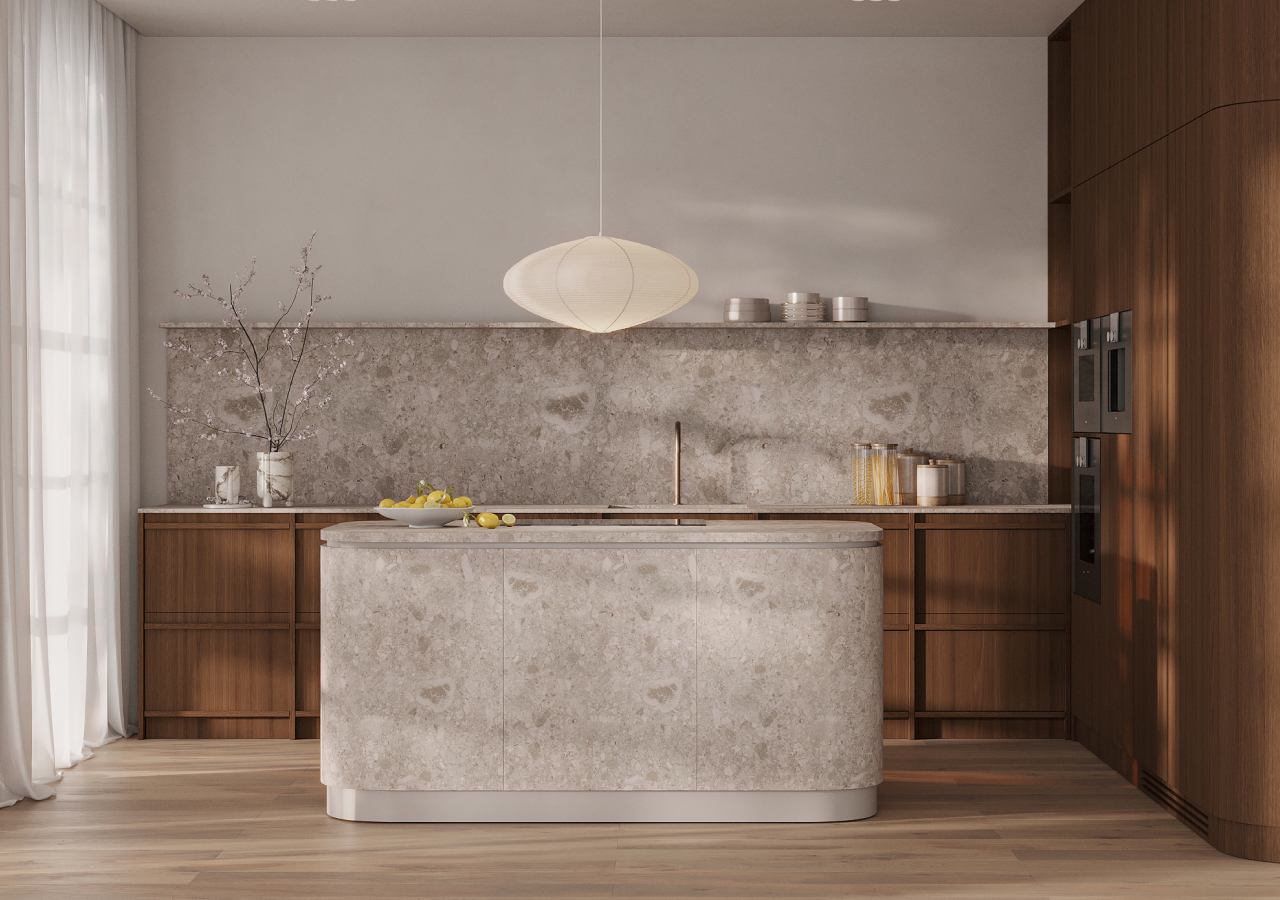A Japandi-style kitchen combines clarity, warmth, and natural simplicity. Materials play an important role in creating this atmosphere. The wood tones, textures, and finishing materials you choose for your interior will significantly impact the functionality and ambiance of your kitchen.
In Japandi kitchen designs, from light oak to rich walnut and dark oak, the right materials contribute to convenient storage, clean lines, and a cozy, comfortable atmosphere. This guide will help you create a kitchen that is not only beautiful but also convenient for everyday use.
Foundations of Japandi Style: Design Principles
.webp)
Japandi design is based on the harmony of two worlds: Japanese restraint and Scandinavian simplicity. This combination is reflected in the choice of materials, which should create a balanced, peaceful space. Natural wood, the basis of the style, adds warmth, while matte surfaces diffuse light, providing a soft and comfortable feel. Organic textures add depth without creating visual noise, and a restrained color palette reinforces the feeling of unity with nature, giving the kitchen a sense of integrity and timeless quality.
In the Japandi style, each material is chosen not only for its decorative qualities but also to support the principles of clarity and functionality. It helps to minimize visual clutter and contributes to the calm functioning of the space. Storage elements such as hidden drawers and built-in fronts reinforce this feeling, allowing materials to flow smoothly into one another and keeping the kitchen light and uncluttered.
Core Materials in Japandi Kitchen Design
Japandi kitchens rely on a short, disciplined list of materials. Focusing on a few high-quality options keeps the palette calm and makes the room feel more spacious and cohesive.
Natural Woods: The Emotional Center of the Kitchen

Light oak, American walnut, and dark oak are key materials for Japandi-style kitchens. Light oak creates a light and airy atmosphere, bringing Scandinavian openness and airiness to the space. Walnut, with its warm tone, adds depth and coziness while remaining minimalist thanks to its smooth texture. Dark oak brings expressive yet understated depth, maintaining the natural elegance that is so important to this style.
All of these wood veneer species are finished with a matte finish, which reduces glare and maintains a warm, pleasant-to-the-touch surface. These materials are ideal for the Japandi style due to their natural beauty, refined patina over time, and ability to blend harmoniously with the rest of the color palette.
Natural and Honed Stone: Quiet Texture and Grounding
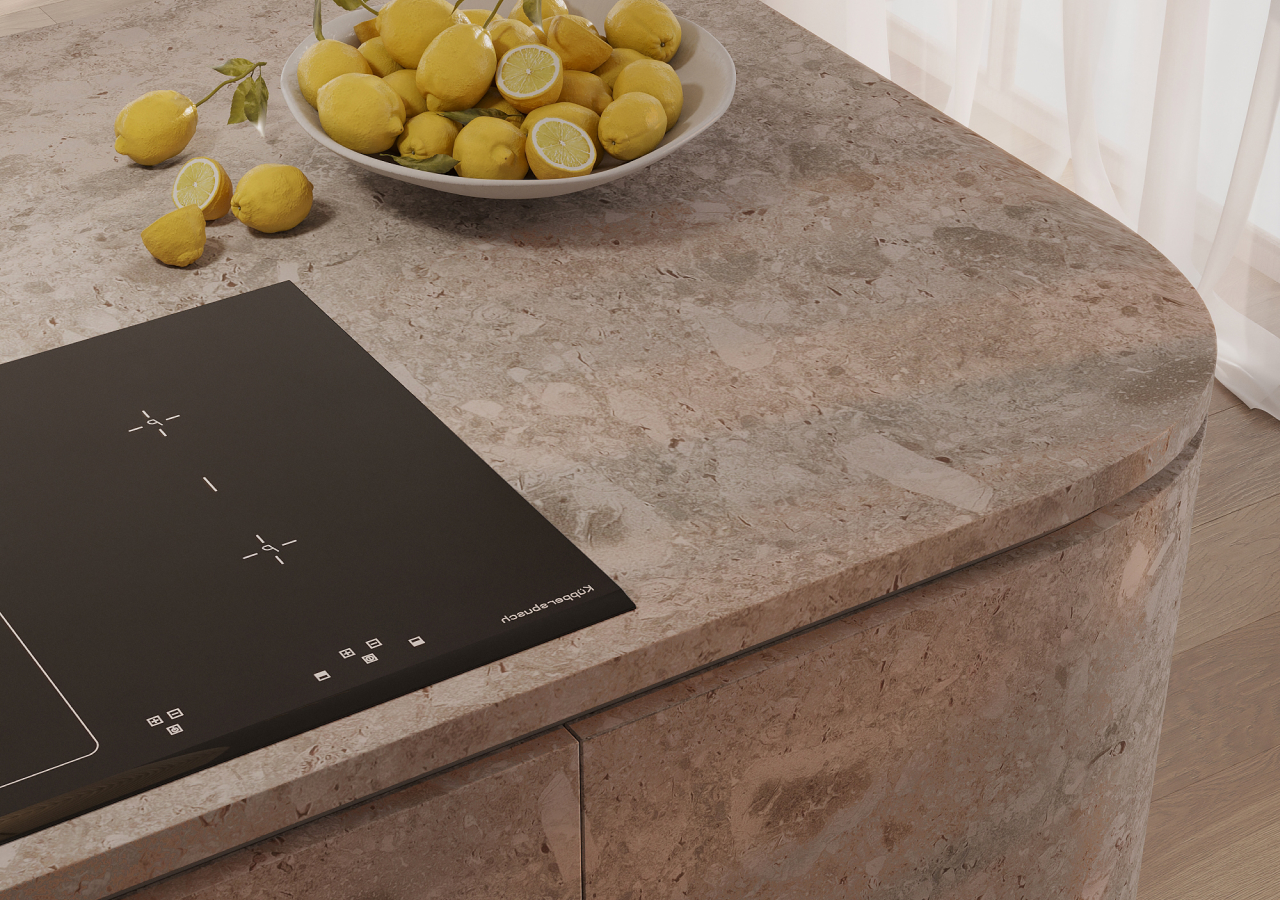
Stone is often used in Japandi kitchens to create a sense of stability and calm. Soft beige, warm gray, and delicate shades reminiscent of travertine, as well as darker slabs for contrast, add architectural rigor. Polished or matte stone fits organically into the interior without overloading the space and maintains harmony with wood materials.
Stone plays a functional role here: countertops, backsplashes, and shelves become not just work surfaces but also part of the restrained architecture, emphasizing the integrity of the style. A stone with a subtle, barely noticeable pattern looks particularly advantageous, maintaining a calm and refined look.
Matte Lacquer and Super-Matte Finishes: Soft Modern Clarity
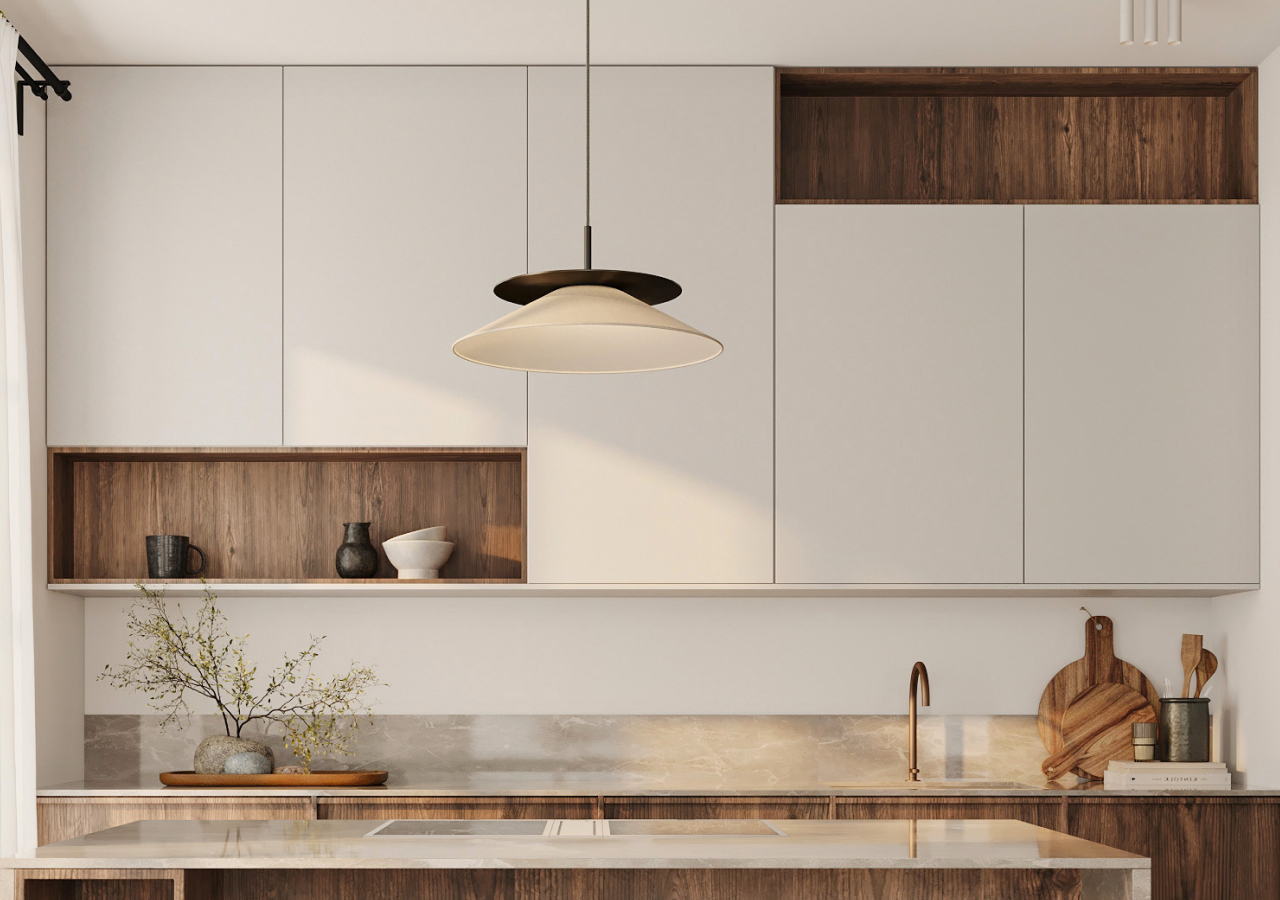
Matte surfaces are an important detail of the Japandi style, supporting a calm and soft atmosphere. They are soft to the touch, reduce glare, and give the space a refined softness. These finishes look especially harmonious when paired with wood veneer fronts: light tones emphasize the naturalness of oak, while deeper neutral shades go well with walnut and dark oak.
By reducing visual noise and making fingerprints less noticeable, matte finishes provide a feeling of comfort and lightness without overloading the interior and emphasizing its minimalist purity.
Ceramics and Stoneware: Everyday Utility with Craft Warmth
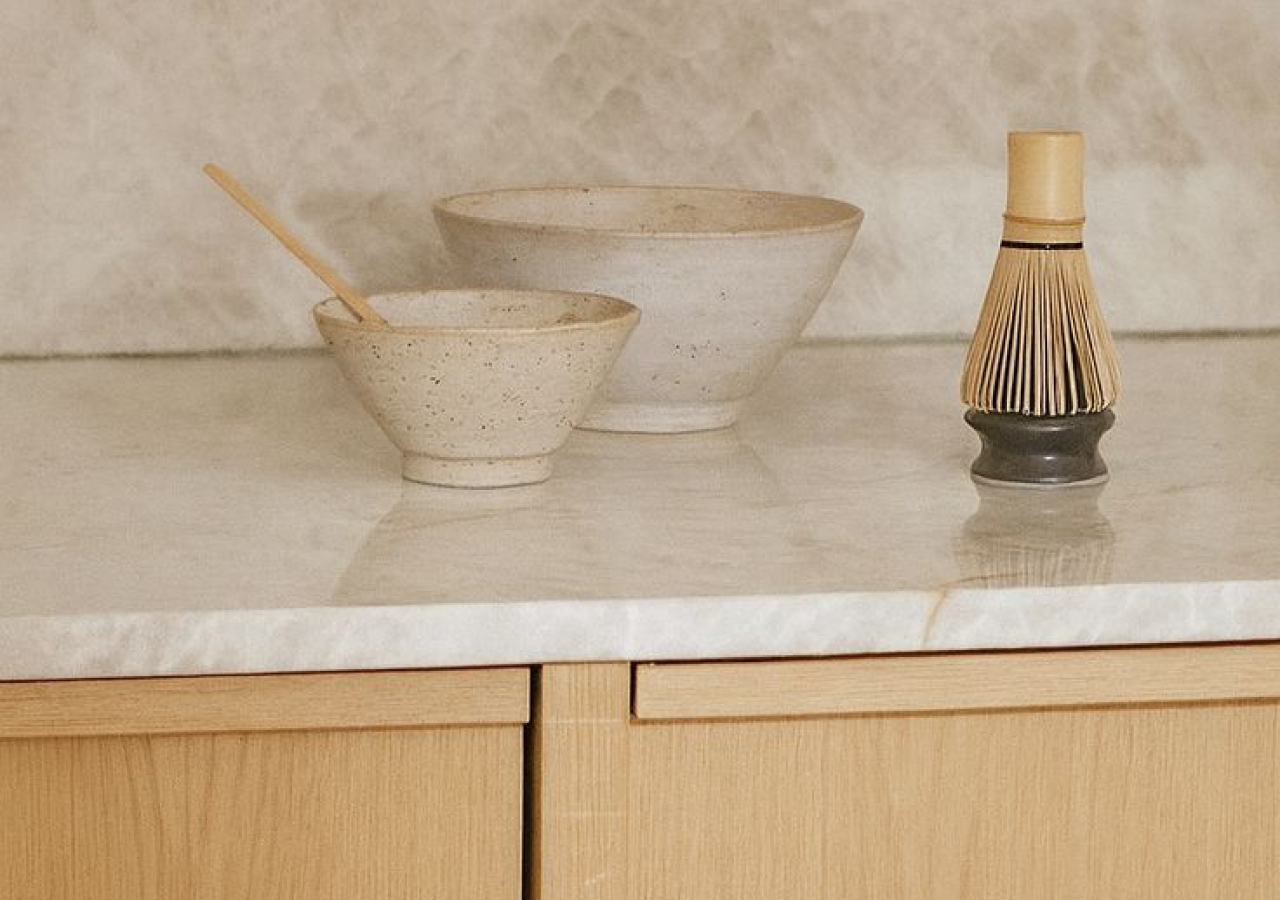
Ceramics bring softness and naturalness to the Japandi-style kitchen thanks to their muted shades, simple shapes, and natural textures. They are often placed on open shelves, in small niches, or behind glass fronts, where they emphasize the feeling of handcrafted work.
When used carefully and thoughtfully, ceramics add coziness to a space while remaining understated and visually clean. That way, they keep one of the key principles of the Japandi style.
Optional Metals: Subtle Functionality When Needed
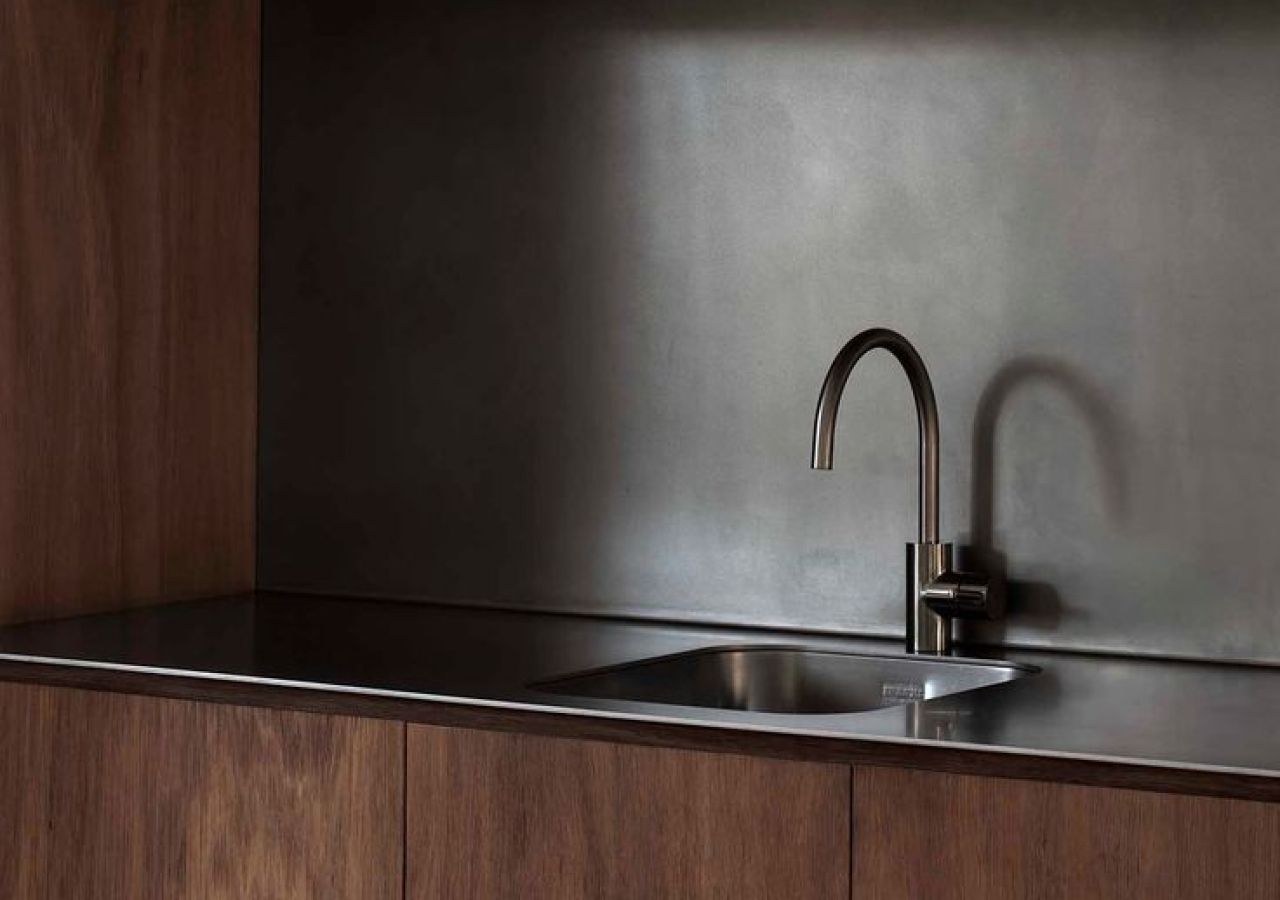
Metals do not play a leading role in Japandi-style kitchens, but subtle accents of stainless steel, matte nickel, or matte black hardware help emphasize functionality.
Moderation is key: appliances and fittings should blend harmoniously into the overall palette without distracting from the wood and other natural materials. Metal is used sparingly to maintain the emphasis on warmth and natural textures in the interior.
Material Combinations That Define Japandi Kitchens
Japandi kitchens usually rely on two or three main materials, repeated consistently. These pairings are popular because they are easy to live with, practical to maintain, and visually balanced.
Wood + Natural Stone: The Classic Japandi Balance

This combination creates a sense of calm through contrast. Light oak paired with white or beige stone makes the kitchen airy and peaceful, especially in open-plan layouts. Walnut with warm-toned stone adds stability and comfort while remaining visually light. Dark oak with softly textured stone creates an expressive, sculptural look that still feels natural. Stone anchors the palette, while wood adds warmth, making the kitchen harmonious and timeless.
Wood + Matte Lacquer: Clean, Soft, Minimalist Layers

The combination of wood veneer cabinets with matte lacquer creates a calm, contemporary rhythm. Light oak bases with white matte tops maintain lightness, while walnut with matte sand or gray tones adds depth without visual overload. This is especially useful for small kitchens, where an all-wood space can feel heavy. Matte lacquer allows for subtle color variations while remaining within the minimalist aesthetic.
Wood + Artificial Stone: Low-Maintenance Calm
.webp)
Engineered surfaces in neutral matte shades provide a clean and sophisticated background. They harmonize with light and dark wood, creating a calm space characteristic of the Japandi style. This choice is practical for busy kitchens: artificial stone looks as soft as natural stone but is easier to care for, maintaining a warm, minimalist aesthetic.
Wood + Glass Accents: Lightness and Breathing Space
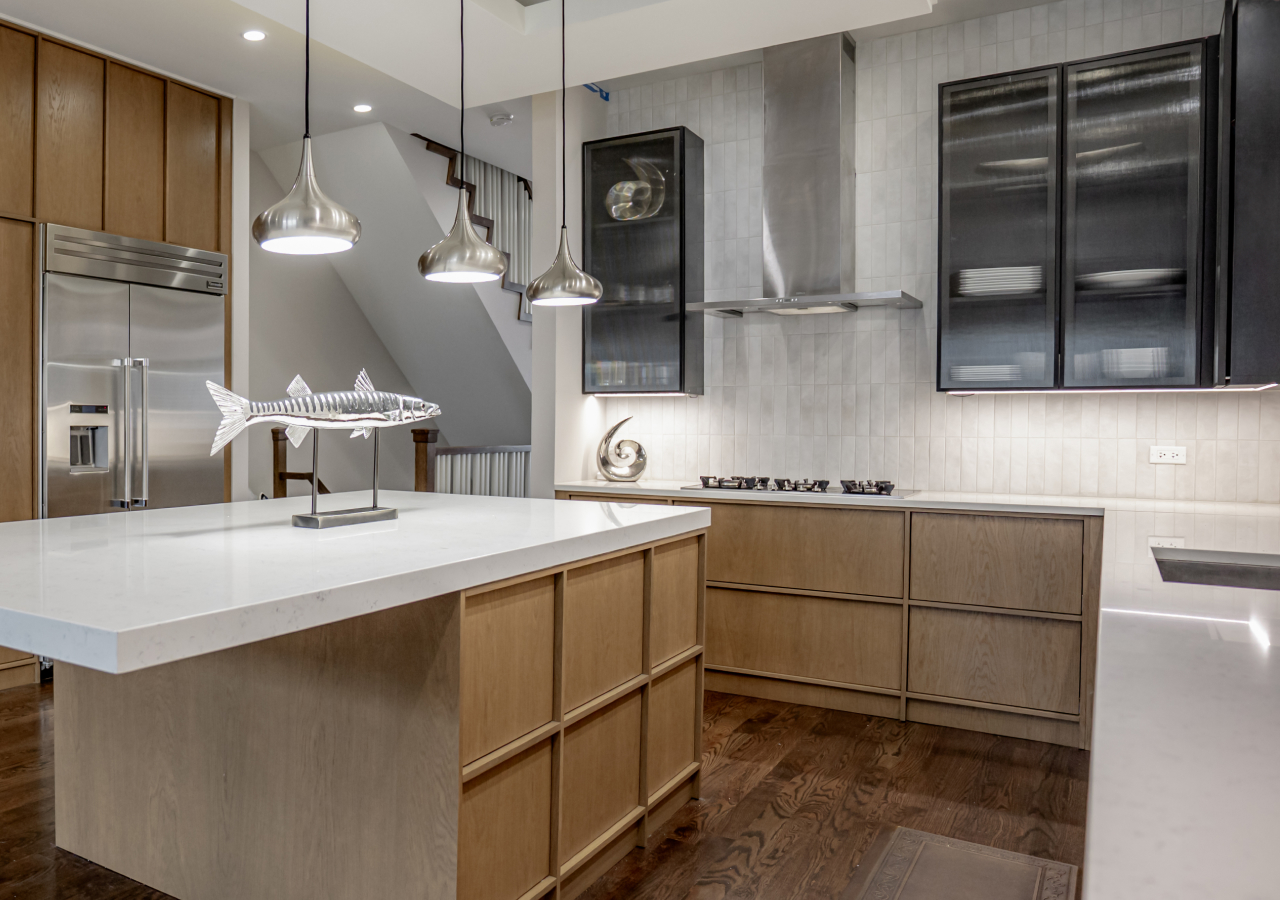
Glass makes Japandi interiors feel more airy, especially when combined with dark wood. It is used in cabinet fronts, shelves, or niches, where transparency creates a feeling of space. When combined with ceramics or simple everyday objects, glass looks functional rather than decorative. It softens hard lines and maintains visual flow, which is especially important in small kitchens or with natural lighting.
Wood + Stainless Steel: Subtle Utility with a Modern Edge
.webp)
Although metals are not a central element of the Japandi style, subtle stainless steel accents harmoniously complement warm wood when used in moderation. Metal emphasizes the functionality of the kitchen without distracting from the texture of oak or walnut. Matte or brushed surfaces are particularly successful in sinks, faucets, fittings, and appliances. This combination creates a neat contrast, supporting minimalism and functionality, making the kitchen both warm and visually calm.
How to Choose the Right Materials for a Japandi Kitchen

Choosing materials for a Japandi kitchen is easier when you follow a clear order. Start with the wood tone, then select the main work surfaces, and finally layer in supporting finishes and textures. Keeping the palette short and calm is what makes the space feel harmonious.
- Start with the wood shade
Wood sets the emotional tone of the interior. Light oak gives a feeling of openness and Scandinavian lightness. American walnut adds warmth and character. Dark oak creates a more expressive, architectural look. Think about the amount of natural light and how cozy or bright you want the space to feel. - Select stone or matte finishes to complement the wood
After choosing wood, pair it with a stone or matte lacquer that supports it instead of competing. Soft beige, warm gray, or off-white stone works well with most woods. For fronts, choose matte finishes in neutral tones that repeat or echo the undertones of the wood. - Limit the number of materials
Aim for two or three main materials and repeat them throughout the space. For example, light oak + beige stone + white matte fronts. This repetition keeps the palette calm and helps the kitchen read as one continuous volume rather than a set of separate elements. - Consider light and texture
Pay attention to how materials interact with natural and artificial light. In Japandi-style kitchens, warm, layered lighting is important. Honed stone, matte fronts, and natural wood should gently diffuse light, avoiding strong glare. If the kitchen is darker, prioritize lighter woods and stones. - Tie everything together with storage and details
High-quality materials work best when the storage systems support them. Clean lines, tall units with continuous fronts, integrated pulls, and well-organized interiors allow the palette to breathe. This keeps the kitchen calm, organized, and pleasant to use every day.
Conclusion
A Japandi kitchen succeeds when its materials work together to create warmth, balance, and calm. Natural woods, soft stones, matte finishes, ceramics, and subtle natural textures shape a space that feels both modern and deeply livable. When chosen intentionally, these materials support a kitchen that stays beautiful through everyday use—simple, grounded, and timeless.
If you’re planning a Japandi kitchen remodel or exploring wood and finish options, Corner Renovation’s collections offer a clear starting point. Thoughtful material choices build a kitchen that feels good every day, and we’re here to help you create one.

